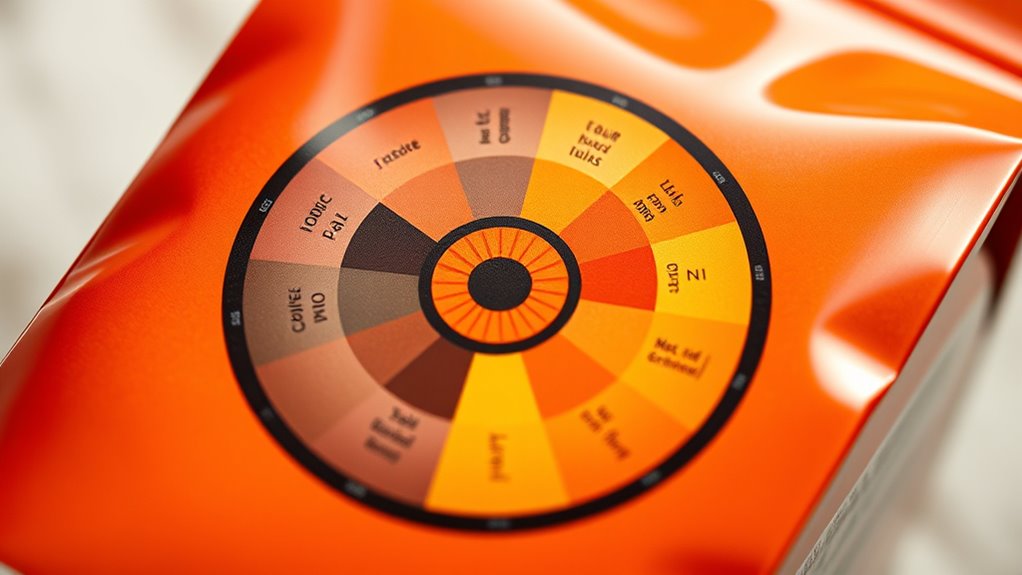To interpret SCA flavor wheels on packaging, start by identifying the main flavor categories like fruity, nutty, or floral on the inner ring. Then, look at the detailed descriptors on the outer ring that match the flavor notes you taste. Recognizing how these terms relate to the specific coffee helps you understand its profile better. Keep practicing, and you’ll soon notice how different descriptors relate to what you experience. If you continue exploring, you’ll uncover even more ways to appreciate coffee flavors deeply.
Key Takeaways
- Identify the main flavor categories on the inner ring, then match specific descriptors to your tasting notes.
- Look for flavor groupings related to the coffee’s origin or processing method to better understand the profile.
- Use the wheel to compare packaging descriptors with actual flavors, enhancing interpretation of terms like “fruity” or “nutty.”
- Recognize primary, secondary, and tertiary flavor layers to appreciate flavor development and subtle nuances.
- Apply the wheel to select complementary foods and communicate tasting experiences with vivid, relatable descriptions.
Understanding the Layout of the SCA Flavor Wheel

The layout of the SCA Flavor Wheel is designed to help you easily identify and categorize different flavor notes in coffee. By understanding its structure, you can improve your sensory training and expand your flavor vocabulary. The wheel is divided into broad categories like fruity, floral, and nutty, which branch into more specific notes. This organization allows you to systematically explore and recognize flavors in your coffee. As you develop your palate, referencing the wheel helps you articulate what you’re tasting more precisely. It’s a visual guide that simplifies complex flavor profiles, making it easier to learn and remember different notes. Using the wheel regularly sharpens your sensory skills and boosts your confidence in identifying subtle flavors. Additionally, familiarizing yourself with the structured layout of the wheel can enhance your ability to distinguish between similar flavor nuances.
Recognizing the Core Flavor Categories

How can you quickly identify the main flavor categories in coffee? Focus on the broad sections of the flavor wheel, which represent the core categories like fruity, spicy, earthy, and floral. These primary categories are shaped by cultural flavor influences and regional flavor profiles, giving each coffee its unique character. Recognizing these core groups helps you understand the general profile without getting lost in specific nuances. For example, a coffee with a fruity label might carry notes influenced by the region’s climate and cultural preferences. By familiarizing yourself with these main categories, you can better interpret packaging descriptions and identify the fundamental flavors that define each coffee’s origin and style. Understanding the core flavor categories can also help you develop your palate and make more informed choices when exploring different coffees. This approach makes it easier to appreciate the diversity reflected in the flavor wheel.
Navigating the Inner and Outer Rings of the Wheel

As you explore the flavor wheel, you’ll notice the inner ring highlights broad flavor groups, while the outer ring offers more specific notes. Recognizing the differences helps you identify where a flavor fits and how it relates to others. This understanding makes it easier to interpret and describe your tasting experience accurately. Developing a sound understanding of the wheel’s structure can enhance your ability to communicate complex flavor profiles effectively.
Differentiating Inner vs. Outer
Guiding the inner and outer rings of the SCA flavor wheel helps you pinpoint specific flavor characteristics more accurately. The inner ring contains broad categories like fruity, nutty, or spicy, giving you a general idea of the flavor profile. The outer ring, on the other hand, offers more detailed descriptors, such as berry, almond, or cinnamon. When you taste coffee, start by identifying which main category the flavor falls into on the inner ring. Then, move outward to the outer ring to find the specific note that matches your experience. This differentiation allows you to describe flavors with greater precision, making your assessments clearer and more consistent. Recognizing the distinct roles of the inner and outer rings enhances your ability to interpret and communicate coffee flavors effectively. Color accuracy and contrast ratio are also important factors that influence the overall perception of quality in home cinema setups.
Recognizing Flavor Groupings
Recognizing flavor groupings on the SCA flavor wheel helps you see patterns and connections between different notes. By understanding these groupings, you can better identify complementary flavors and improve your sensory evaluation skills. The inner ring often groups related core flavors, while the outer ring highlights specific notes within those categories. When you notice these connections, it becomes easier to suggest flavor pairing ideas that enhance a product’s profile. This awareness also helps you interpret packaging labels more effectively, as they often reference flavor groups. With practice, you’ll develop a sharper palate and a deeper understanding of how different notes interact, making your tasting experience more insightful and enjoyable. Additionally, understanding flavor groupings can guide you in creating balanced and harmonious flavor profiles in your own culinary or beverage experiments.
Identifying Primary, Secondary, and Tertiary Flavors
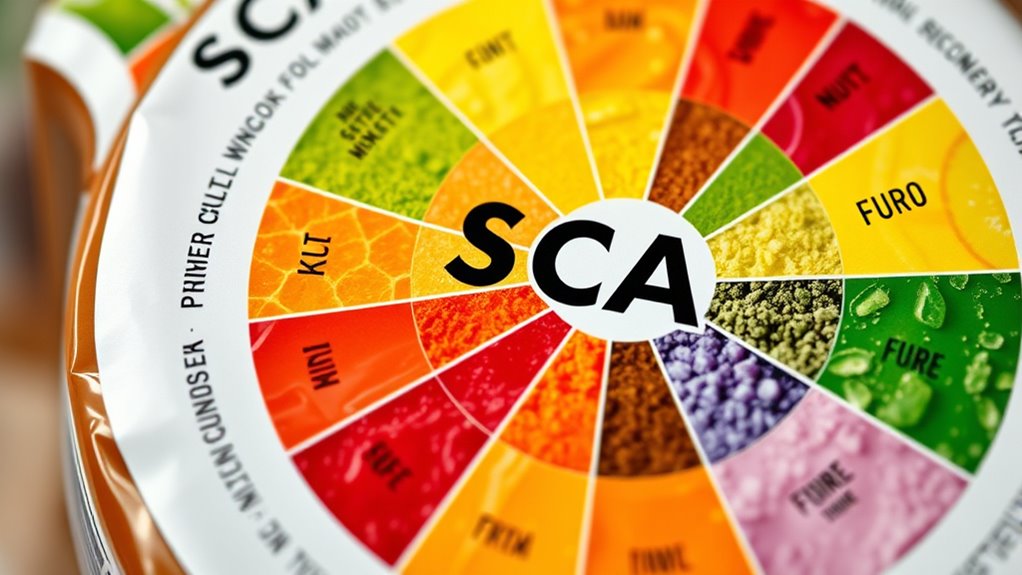
Have you ever wondered how to distinguish between the different flavor levels on a flavor wheel? It all comes down to understanding primary, secondary, and tertiary flavors through sensory vocabulary and flavor mapping. Primary flavors are the most prominent and usually align with the main ingredients, like citrus or berry notes. Secondary flavors develop from processing or blending, adding nuance, such as caramel or floral hints. Tertiary flavors are subtler, often emerging during tasting or aftertaste, like spicy or woody notes. Using precise sensory vocabulary helps you identify these layers more accurately. Flavor mapping guides you in visualizing how flavors evolve from dominant to subtle. Recognizing these levels sharpens your palate and enhances your ability to interpret flavor wheels on packaging effectively.
Using Descriptive Terms to Articulate Flavors

Ever wondered how to effectively communicate the flavors you’re experiencing? Using precise sensory vocabulary helps you articulate flavor expression clearly. Start by identifying the core taste or aroma, then select descriptive terms that match your perception. Instead of vague words like “fruity,” specify “bright citrus” or “ripe berry” to add clarity. When describing flavors, focus on common sensory vocabulary that captures nuances—think “earthy,” “nutty,” or “floral.” This precision enhances your ability to share your experience with others and deepen your tasting skills. Remember, the goal is to use language that accurately reflects what you perceive, making your flavor descriptions more vivid and meaningful. Developing a rich vocabulary makes your flavor expression more compelling and easier to understand. Additionally, understanding the subtopics related to flavor profiles can help you better interpret and describe complex tastes.
Connecting Aromas to Flavor Profiles

How do you connect the aromas you detect with the flavors you experience? It starts by recognizing aroma combinations and understanding how they influence flavor development. When you smell certain scents, they often hint at specific taste qualities, such as fruity, nutty, or spicy notes. By noting these aroma combinations, you can anticipate how they’ll translate on your palate. For example, a citrus aroma may lead to a bright, tangy flavor, while a floral scent might suggest a delicate, sweet profile. Paying attention to these connections helps you build a more complete sensory picture. Over time, you’ll notice patterns between what you smell and what you taste, making it easier to interpret flavor profiles and appreciate the complexity of your favorite beverages. Recognizing aroma blends and their influence on flavor can enhance your sensory analysis skills.
Comparing Flavor Descriptions With Packaging Labels
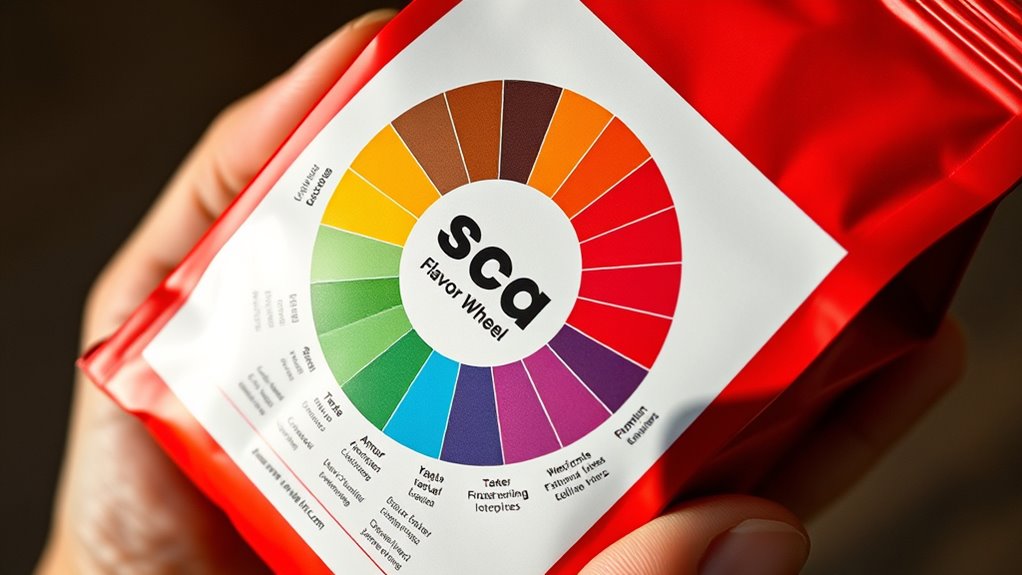
When comparing flavor descriptions on packaging labels, you’ll want to focus on matching terms to your tasting notes. Pay attention to how descriptive language translates into actual flavors, and see where they align or differ. This helps you better understand the product and refine your palate.
Matching Flavor Terms
Have you ever noticed how flavor descriptions on packaging can sometimes feel vague or different from what you actually taste? When matching flavor terms, focus on how packaging labels pair flavor terms with specific tasting notes. This connection helps deepen your understanding of how flavor profiles are communicated and perceived. Keep in mind that flavor terminology development varies among companies, so similar terms might have different meanings. To improve your understanding, compare the flavor wheel’s categories with the terms on the packaging. Look for commonalities or differences in descriptors like “fruity,” “nutty,” or “bright.” Over time, this practice trains your palate and sharpens your ability to interpret packaging language accurately, making your tasting experience more intentional and insightful.
Deciphering Descriptive Language
Deciphering descriptive language involves actively comparing the flavor descriptions on packaging with the terms used on flavor wheels. Pay attention to sensory vocabulary, which often highlights specific tastes or aromas, like “fruity” or “nutty.” When labels use descriptive words, consider how they match the flavor wheel’s categories and terminology. For example, if a label mentions “bold flavor” or “rich aroma,” assess whether it indicates high flavor intensities, which can be more vivid or pronounced. Recognize that packaging descriptions may be more subjective, so your goal is to find common ground between the language used and the standardized terms on the wheel. This comparison helps you better understand the flavor profile and enhances your ability to identify subtle nuances.
Applying the Wheel to Different Types of Coffee and Food
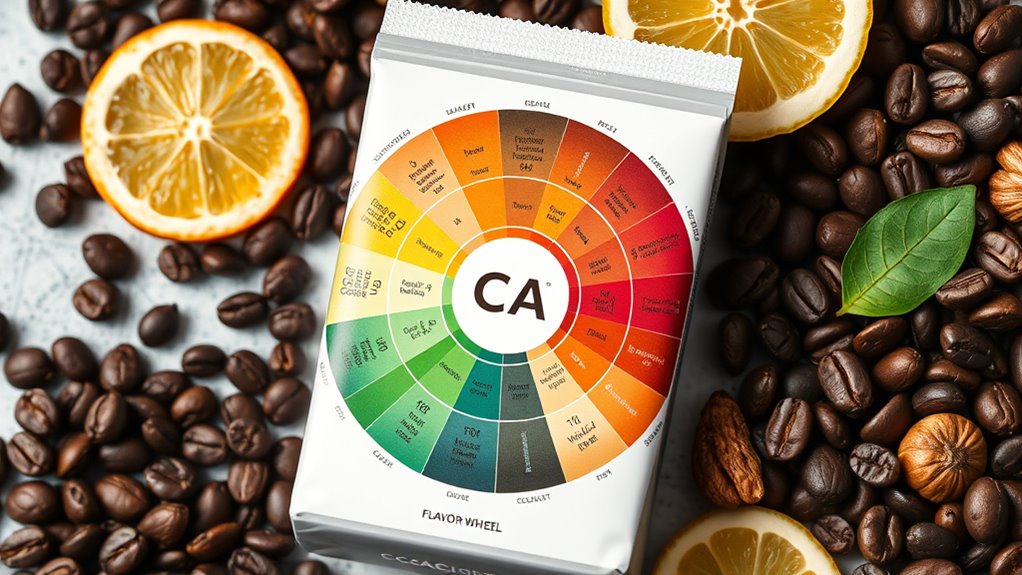
Ever wondered how the SCA flavor wheel can enhance your experience with different coffees and foods? You can use the wheel to improve pairing coffee with foods by identifying complementary flavors. For example, if your coffee has citrus notes, try pairing it with fruit-based desserts or salads. Using flavor wheels in cooking helps you balance acidity, sweetness, and bitterness, creating harmonious dishes. When selecting foods to accompany your coffee, look for shared flavor notes on the wheel. This approach allows you to experiment confidently, whether you’re brewing a morning cup or preparing a meal. Applying the wheel to various coffee types and foods makes the tasting experience more intentional and enjoyable, helping you discover new flavor combinations and elevate your culinary adventures.
Developing Your Palate With Practice and Tasting Notes
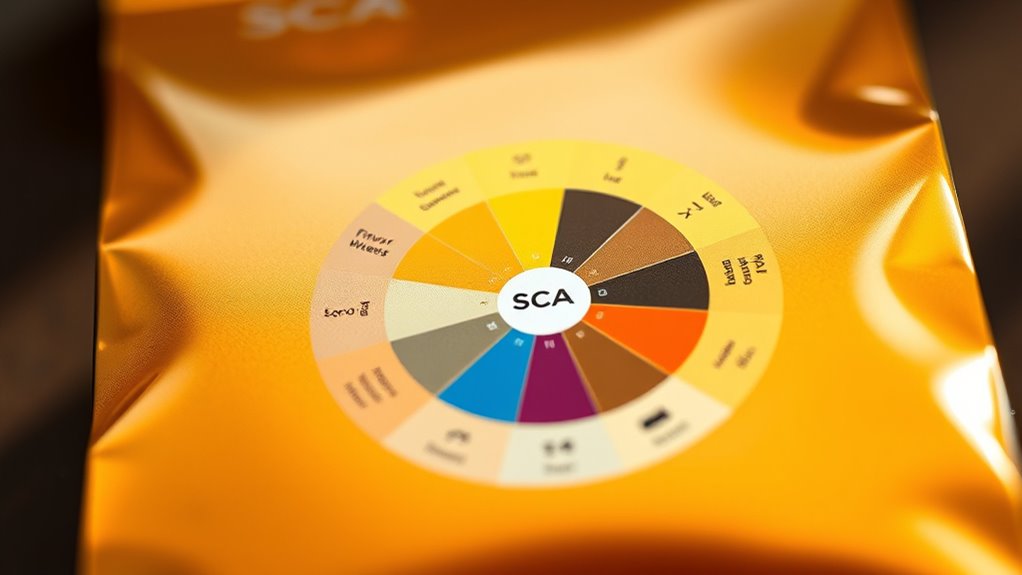
By tasting regularly, you sharpen your sensitivity to subtle flavors and nuances. Keep detailed notes on what you experience to help identify patterns and improve your palate. Reflecting on these notes over time makes your tasting skills more precise and confident. Incorporating exotic fruit blend inspirations can also expand your flavor recognition and appreciation.
Tasting Regularly Enhances Sensitivity
Practicing tasting regularly is one of the most effective ways to sharpen your palate and become more attuned to subtle flavors. With consistent practice, your sensory memory strengthens, helping you recognize nuances and build a richer flavor vocabulary. As you taste, you notice how different notes interact, creating flavor synergy that enhances your overall experience. To develop this sensitivity, consider:
- Tasting a variety of coffees to compare sweetness, acidity, and body
- Paying close attention to how flavors evolve over time
- Keeping a tasting journal to track your impressions and progress
- Exploring different flavor wheels to better understand and interpret complex profiles
This routine trains your palate to detect delicate aromas and flavors more quickly. Over time, your ability to interpret flavor wheels improves, making it easier to identify and appreciate the complex profiles on packaging.
Record and Reflect on Flavors
How can you deepen your understanding of flavors? The key is to record and reflect on your tasting experiences. Keep a journal of tasting notes, noting flavors, aromas, and sensations. This habit helps identify patterns, improve your palate, and refine pairing suggestions. Experiment with different brewing techniques to see how they influence flavor profiles. To make it easier, try this table:
| Flavor Notes | Pairing Suggestions |
|---|---|
| Bright citrus | Light breakfast pastries |
| Earthy undertones | Dark chocolate or roasted nuts |
| Fruity sweetness | Spiced desserts or fruit salads |
Review your notes regularly. Over time, you’ll develop a more nuanced palate, making every tasting session more insightful and enjoyable.
Tips for Communicating Flavors Effectively to Others
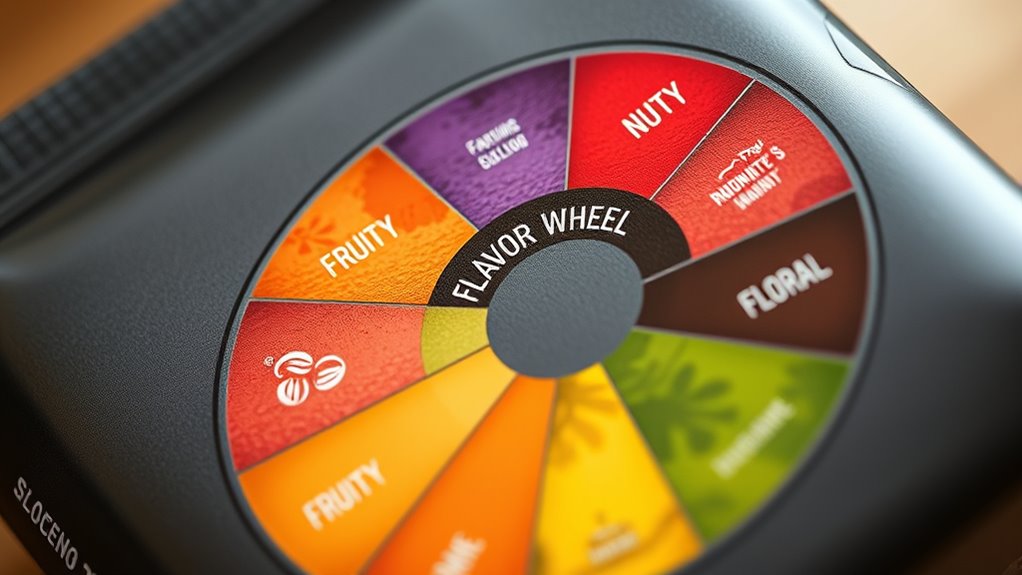
Communicating flavors effectively requires more than just describing tastes; it involves sharing your sensory experiences in a way that others can understand and relate to. To do this, consider using relatable comparisons, such as pairing suggestions or flavor pairing ideas, that connect flavors to familiar foods or experiences. When describing a flavor, paint a vivid picture with details about aroma, texture, and taste, helping others imagine the experience. You might say, “It has a bright citrus note, like a fresh lemon,” or “a smooth, chocolatey undertone that’s rich and comforting.” To enhance understanding, incorporate sensory words that evoke images or emotions, making your descriptions more engaging and memorable. Clear, concise language helps others grasp complex flavor profiles effortlessly.
Frequently Asked Questions
How Do I Interpret Unfamiliar or Complex Flavor Descriptors on the Wheel?
When you encounter unfamiliar or complex flavor descriptors, focus on understanding the flavor terminology and how they relate to taste. Use the wheel as a guide to see connections between descriptors, which helps refine your palate. Don’t get overwhelmed—try to interpret each term based on your sensory experience. Over time, you’ll become more confident in descriptor interpretation, making it easier to identify subtle flavors and deepen your appreciation for coffee nuances.
Can the SCA Flavor Wheel Be Used for Non-Coffee Beverages?
Did you know over 70% of baristas use the SCA flavor wheel for non-coffee beverages? You can definitely adapt the flavor wheel for non-coffee drinks, as it’s designed to identify and describe flavors broadly. By focusing on aroma, taste, and mouthfeel, you’ll find it useful for teas, smoothies, or craft sodas. Just tweak the categories to suit your beverage, making flavor exploration more precise and enjoyable.
How Does Roasting Level Affect Flavor Perception on the Wheel?
You’ll notice that roasting level profoundly impacts flavor perception on the wheel. A darker roast brings out more intense, bold flavors, increasing flavor intensity, while a lighter roast emphasizes brighter, more nuanced notes. The roasting impact shapes how you interpret the wheel’s flavor categories, making certain qualities stand out more depending on the roast. So, consider the roast level to better understand and appreciate the flavor profile you’re experiencing.
Is the Flavor Wheel Applicable for Tasting Coffee at Different Brew Strengths?
Imagine savoring your coffee at different brew strengths—each sip transforms flavor perception. The flavor wheel is still useful, helping you identify nuances regardless of brew strength. While a stronger brew might intensify certain flavors, a lighter one reveals subtler notes. So yes, the flavor wheel applies across brew strengths, guiding you to appreciate the complex layers and enhancing your tasting experience, no matter how you brew your coffee.
How Can I Customize the Flavor Wheel to Suit My Personal Palate?
You can customize the flavor wheel to suit your personal palate by identifying which flavors you naturally prefer or dislike. Start by tasting different coffees and noting your flavor preference adjustments, then modify the wheel accordingly. Highlight or rearrange flavors that resonate most with you, making it easier to recognize your unique palate. Personal palate customization helps you better understand your taste, guiding you to select coffees that align with your flavor preference adjustment.
Conclusion
Mastering the SCA flavor wheel enhances your tasting experience and helps you communicate flavors more confidently. Did you know that over 80% of coffee professionals use flavor wheels to refine their palate? By regularly practicing and referring to the wheel, you’ll develop a more nuanced appreciation of flavors in coffee and food. Keep exploring, stay curious, and soon you’ll be describing flavors with clarity and precision that impress others.
